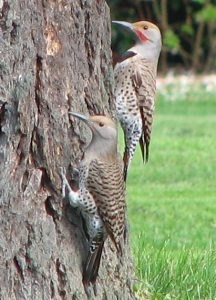Woodpecker That Feeds on the Ground
There is something strange afoot. Longmont is home to a woodpecker that likes to hang out on the ground. You may have seen them while on a walk, or caught a glimpse of one as it flies away. If you have a suet feeder, you certainly may see one.
This content was originally published by the Longmont Observer and is licensed under a Creative Commons license.
There is something strange afoot. Longmont is home to a woodpecker that likes to hang out on the ground. You may have seen them while on a walk, or caught a glimpse of one as it flies away. If you have a suet feeder, you certainly may see one. What is it? It is a northern flicker.
Flickers are relatively large woodpeckers that are about 11-12 inches long. They are brownish in color overall. Flickers have a white patch on their rump that is visible when perched and very obvious when they are in flight. The brown plumage has little black spots, bars, and crescents all over it. Flickers also have a black crescent on their upper chest. The undersides of the wings and tail feathers are red in color. The male has a bright red "mustache." Both sexes may have a bright red nape as well, although not all flickers have this. The red nape is a product of interbreeding between red-shafted and yellow-shafted flickers. The difference between the two species has to do with the color of the feather shaft, which is yellow in yellow-shafted flickers and red in red-shafted flickers. They used to be thought of as separate species, but much interbreeding has occurred.

Flickers can be found in open habitats near trees. This includes woodlands, parks, and yards. In Colorado, you can find them all the way up to the tree line! You may also find flickers in wet habitats such as marsh edges and streamside woods. Flickers in Longmont are year-round residents, but those from Canada and Alaska migrate south for the winter.
As mentioned, flickers prefer to feed on the ground rather than in trees like most woodpeckers. Their diet is made up primarily of insects, especially ants and beetles. Flickers will hammer at soil the way other woodpeckers hammer wood looking for ants. The nutritious ant larvae are underground. Flickers are well-suited to catching ants because they can stick their tongues out two inches beyond the end of their bill. Their tongues are sticky allowing them to pick up ants and larvae easily. They have even been observed breaking up cow patties and eating the ants and beetles living inside.
During the winter, flickers also eat berries and seeds. They forage by hopping along the ground or climbing tree trunks and limbs. Flickers will occasionally catch flying insects in the air. They may perch in trees to eat berries. When perched in a tree, flickers usually perch upright rather than leaning on their tails against a trunk. Depending on the density of birds during breeding season, flickers may forage alone or in groups called a "guttering" or a "menorah." During the winter, flickers are more likely to forage in groups.

Sometime during the late spring, flickers will begin to choose mates. Flickers are generally monogamous during the breeding season. It is difficult to distinguish courtship behavior from territorial behavior. However, two males may face off in a "fencing duel" while a prospective female looks on. The two males face each other on a branch with their bills pointing upward and bob their heads while drawing a figure eight in the air. Accompanying this is a rhythmic wicka-wicka call. Males may also drum to defend their territory.
How flickers choose their nest site is not known, but they may tap on a trunk together while selecting a site. Flickers usually excavate cavities in dead tree trunks and limbs. Both sexes participate in excavating the nest, but the male has a dominant role. Flickers may also reuse a nest cavity from the previous year or one another woodpecker previously excavated. The nest cavity curves downward sharply from the entrance with the diameter becoming wider toward the bottom of the cavity. The cavity is about 13-16 inches deep. The entrance to the cavity is only large enough to allow an adult to enter the nest, about three inches in diameter. The cavity itself is cylindrical with a bed of wood chips. Nest are typically located 6-20 feet above the ground.

Females lay between five and eight eggs in a clutch with only one clutch per season. Both sexes incubate the eggs, with the male incubating the eggs at night. Incubation lasts 11-13 days. The young are born naked and helpless (altricial) with closed eyes. Both parents participate in feeding the young by regurgitation. Until they are about 11 days old, nestlings huddle on the bottom of the cavity on wood chips. After that, they will lay along the walls with their chins and throats pressed against the wall. By day 17, they are strong enough to cling to the walls of the nest cavity. The young will leave the nest (fledge) at about four weeks of age. Once they fledge, the young follow the adults to foraging sites.
To find flickers, look on the ground in open areas where you may see them foraging. Flickers fly in an undulating (up and down) pattern and their white rump patch is clearly visible in flight. You can also listen for the characteristic kikikiki call or peough call. You may consider putting up a suet feeder this winter as flickers will feed at them. These beautiful woodpeckers can be a welcome backyard visitor.
wanamakerparme1936.blogspot.com
Source: https://www.longmontleader.com/local-news/northern-flicker-woodpecker-ground-2382084
0 Response to "Woodpecker That Feeds on the Ground"
Post a Comment